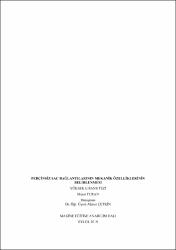| dc.contributor.advisor | Çetkin, Ahmet | |
| dc.contributor.author | Turan, Murat | |
| dc.date.accessioned | 2020-11-10T05:58:39Z | |
| dc.date.available | 2020-11-10T05:58:39Z | |
| dc.date.issued | 2019 | en_US |
| dc.identifier.uri | https://hdl.handle.net/11630/8439 | |
| dc.description.abstract | Bu araştırmada, Türk otomotiv sektörünün yenilerde tanıştığı sac birleştirme yöntemi olan form punta birleştirme yönteminin TS EN 10346 sacların üzerindeki uygulamaları incelenecektir. Endüstriyel sanayi kollarında, özellikle otomotiv sanayisinde birleştirme maliyetlerini azaltmak ve estetik bir görünüm elde etmek için son yıllarda tercih edilen form punta sac birleştirme yöntemi, ek bir bağlantı elemanına ihtiyaç duyulmaksızın sac levhaları birleştirme yönetimidir. Yöntemin vida, perçin gibi yabancı ara parça ve ek materyallere ihtiyaç duymadan, birleştirilecek levha malzemelerin sadece kendisini şekillendirerek birleştirme avantajı bulunmaktadır. Punta form sac birleştirme metodunu kullanarak, özellikle perçinli birleştirme yönetiminde ortaya çıkan ara parça ihtiyacı, kaynaklı birleştirmedeki kalifiye işçi maliyeti, iş güvenliği ve iş sağlığı üzerindeki istenmeyen durumların ortadan kaldırılmasını sağlamaktadır. Özellikle otomotiv endüstrisindeki robotik kullanımına da uygun olan bu yöntem sayesinde, farklı kalınlıkta ve farklı özellikteki sac levhaların birleştirilmesi, maliyet avantajı ve enerji kazanımı da sağlayacaktır.
Otomotiv endüstrisinde gövde ve diğer aksesuarlarında kullanılan Erdemir 1312 kalite sacların (TS EN 10346), punta form birleştirme yöntemiyle birleştirilmesi ile oluşan bağlantıların mekanik özelliklerinin incelenmesi amaçlanmıştır. Birleştirilen numunelere TS EN ISO 14273 standardına göre kesme deneyi ve TS EN ISO 14270 standardına göre mekanize soyma deneyi uygulanmıştır. | en_US |
| dc.description.abstract | In this study, the applications of the Clinching technic, which is the sheet metal joining method that Turkish automotive industry has recently met, will be examined on TS EN 10346 sheets. In the industrial industry, especially in the automotive industry, in order to reduce the cost of joining and to achieve an aesthetic appearance, the preferred method of tacking sheet metal joining method is the management of joining of sheet metal without the need for an additional fastener. The method has the advantage of joining only the sheet materials to be joined, without the need for foreign and additional materials such as screws, rivets. Using the clinching method, the need for parts, especially in the management of riveted jointing, eliminates the undesirable situations on the part of skilled workers in the welded joint, occupational health and safety. This method, which is also suitable for the robotic use in the automotive industry, will enable the combination of sheet metal of different thicknesses and different properties, cost advantage and energy recovery.
In order to examine the mechanical properties of the joints formed by the joining of Erdemir 1312 quality sheets (TS EN 10346), which are used in body and other accessories in the automotive industry with the clinching method, the samples prepared in accordance with the standards were combined with the joining method. Shearing test according to TS EN ISO 14273 standard and mechanized peeling test according to TS EN ISO 14270 standard have been applied to the joined samples. | en_US |
| dc.language.iso | tur | en_US |
| dc.rights | info:eu-repo/semantics/openAccess | en_US |
| dc.subject | perçinsiz sac birleştirme | en_US |
| dc.subject | form punta | en_US |
| dc.subject | clinching, sheet metal | en_US |
| dc.subject | joining | en_US |
| dc.subject | otomotiv | en_US |
| dc.title | Perçinsiz sac bağlantılarının mekanik özelliklerinin belirlenmesi | en_US |
| dc.title.alternative | Determınatıon of mechanıcal Propertıes of sheet metal joınts wıthout usıng rıvets | en_US |
| dc.type | masterThesis | en_US |
| dc.department | Mühendislik Fakültesi | en_US |
| dc.identifier.startpage | 1 | en_US |
| dc.identifier.endpage | 53 | en_US |
| dc.relation.publicationcategory | Tez | en_US |
| dc.contributor.institutionauthor | Turan, Murat | |



















